The Influence of Strip-City Street Network Structure on Spatial Vitality: Case Studies in Lanzhou, China
Abstract
1. Introduction
2. Regions and Dataset
2.1. Regional Overview
2.2. Dataset
2.2.1. Dataset of Streets
2.2.2. Point of Interest Data
2.2.3. Baidu Heatmap Data
3. Methods
3.1. Street Network Accessibility Evaluation
3.2. Spatial Vitality Measurement
3.3. Hotspot Analysis (Getis-Ord Gi*)
3.4. Relevance Exploration
3.5. Spatial Doberman Model
4. Results
4.1. Street Network Structure Based on Space Syntax
4.2. Temporal and Spatial Distribution Characteristics of Spatial Vitality
4.2.1. Temporal Characteristics of Spatial Vitality
- On weekdays and weekends, based on spatial vitality, the concentration of vitality during the day is significantly greater than that at night. This is in line with common sense that the concentration of people in residential areas is lower than that of areas with public activities, thus providing the facial validity of our research results.
- Regarding the degree of population concentration, the vitality value of the city center during workdays is generally higher than that on weekends, and the crowd on workdays is more concentrated than on weekends. After 11:00 pm, the trend of gathering vitality on weekends is higher than that on weekdays. The vitality of streets at night mainly comes from weekend activities.
- Comparing the volatility of the vitality aggregation curve, the volatility of most working days is greater than that of the weekend, which is related to urban commuting. Comparing the curvature of the morning and afternoon curves shows that people gather and disperse faster on weekdays than on weekends.
4.2.2. Spatial Characteristics of Urban Vitality
4.3. Correlation Analysis of Street Accessibility and Spatial Vitality
4.4. The Influencing Mechanism of Street Accessibility on Space Vitality
4.4.1. Overall Spatial Effect
4.4.2. Temporal Heterogeneity Effect
5. Discussion and Conclusions
- The temporal distribution of urban vitality is consistent with the law of crowd activities, showing highly similar spatial aggregation and dispersion, and the spatial distribution of vitality mostly coincides with the location of street intersections.
- At the level of urban spatial neighborhoods, the better the connectivity of the street network, the more vibrantly the city gathers. For streets with high controllability, and with more transfer steps, the more scattered the urban vitality is. Certain factors, for instance shopping and services in the spatial dimension, have influenced urban vitality to a large extent.
- According to travel habits on weekdays and weekends, the GInteg and LInteg are significantly related to urban vitality, but there is a temporal heterogeneity effect.
Author Contributions
Funding
Data Availability Statement
Acknowledgments
Conflicts of Interest
References
- Zhao, P. Sustainable urban expansion and transportation in a growing megacity: Consequences of urban sprawl for mobility on the urban fringe of Beijing. Habitat Int. 2010, 34, 236–243. [Google Scholar] [CrossRef]
- Shi, G.; Shan, J.; Ding, L.; Ye, P.; Li, Y.; Jiang, N. Urban road network expansion and its driving variables: A case study of Nanjing City. Int. J. Environ. Res. Public Health 2019, 16, 2318. [Google Scholar] [CrossRef] [PubMed]
- Tang, T.Q.; Shi, W.F.; Yang, X.B.; Wang, Y.P.; Lu, G.Q. A macro traffic flow model accounting for road capacity and reliability analysis. Phys. A Stat. Mech. Its Appl. 2013, 392, 6300–6306. [Google Scholar] [CrossRef]
- Barton, H.; Grant, M.; Guise, R. Shaping Neighbourhoods: A Guide for Health, Sustainability and Vitality; Taylor & Francis: London, UK, 2003. [Google Scholar]
- Montgomery, J. Making a city: Urbanity, vitality and urban design. J. Urban Des. 1998, 3, 93–116. [Google Scholar] [CrossRef]
- Qian, Y.S.; Wang, M.; Kang, H.X.; Zeng, J.W.; Liu, Y.F. Study on the road network connectivity reliability of valley city based on complex network. Math. Probl. Eng. 2012, 2012, 430785. [Google Scholar] [CrossRef]
- Teng, L.; Yang, Y. The study on the traffic problems of valley-city—A case study of Lanzhou City. Econ. Geogr. 2002, 22, 72–75. [Google Scholar]
- Jacobs, A.B. Great Streets; The MIT Press: Cambridge, MA, USA, 1993; ISBN 9780262100489. [Google Scholar]
- Fang, C.; He, S.; Wang, L. Spatial Characterization of Urban Vitality and the Association With Various Street Network Metrics From the Multi-Scalar Perspective. Front. Public Health 2021, 9, 677910. [Google Scholar] [CrossRef]
- Guo, X.; Chen, H.; Yang, X. An Evaluation of Street Dynamic Vitality and Its Influential Factors Based on Multi-Source Big Data. ISPRS Int. J. Geo-Inf. 2021, 10, 143. [Google Scholar] [CrossRef]
- Fuentes, L.; Miralles-Guasch, C.; Truffello, R.; Delclòs-Alió, X.; Flores, M.; Rodríguez, S. Santiago de Chile through the eyes of Jane Jacobs. Analysis of the conditions for urban vitality in a Latin American metropolis. Land 2020, 9, 498. [Google Scholar] [CrossRef]
- Cafuta, M.R. Open Space Evaluation Methodology and Three Dimensional Evaluation Model as a Base for Sustainable Development Tracking. Sustainability 2015, 7, 13690–13712. [Google Scholar] [CrossRef]
- Liu, S.; Zhang, L.; Long, Y.; Long, Y.; Xu, M. A New Urban Vitality Analysis and Evaluation Framework Based on Human Activity Modeling Using Multi-Source Big Data. ISPRS Int. J. Geo-Inf. 2020, 9, 617. [Google Scholar] [CrossRef]
- Bardhan, R.; Kurisu, K.; Hanaki, K. Does compact urban forms relate to good quality of life in high density cities of India? Case of Kolkata. Cities 2015, 48, 55–65. [Google Scholar] [CrossRef]
- Ye, Y.; Li, D.; Liu, X. How block density and typology affect urban vitality: An exploratory analysis in Shenzhen, China. Urban Geogr. 2018, 39, 631–652. [Google Scholar] [CrossRef]
- Jacobs, J. The Death and Life of Great American Cities, 1st ed.; Vintage Books: New York, NY, USA, 1961. [Google Scholar]
- Dong, Y.-H.; Peng, F.-L.; Guo, T.-F. Quantitative assessment method on urban vitality of metro-led underground space based on multi-source data: A case study of Shanghai Inner Ring area. Tunn. Undergr. Space Technol. 2021, 116, 104108. [Google Scholar] [CrossRef]
- Xu, X.; Xu, X.; Guan, P.; Ren, Y.; Wang, W.; Xu, N. The cause and evolution of urban street vitality under the time dimension: Nine cases of streets in Nanjing City, China. Sustainability 2018, 10, 2797. [Google Scholar] [CrossRef]
- Zeng, J.; Qian, Y.; Ren, Z.; Xu, D.; Wei, X. Road Landscape Morphology of Valley City Blocks under the Concept of “Open Block”—Taking Lanzhou City as an Example. Sustainability 2019, 11, 6258. [Google Scholar] [CrossRef]
- Zakerhaghighi, K. Urban vitality evaluation in vali asr crossroad on the basis of activity patterns. Bagh-E Nazar 2019, 16, 5–18. [Google Scholar]
- Yang, Y.; Ma, Y.; Jiao, H. Exploring the Correlation between Block Vitality and Block Environment Based on Multisource Big Data: Taking Wuhan City as an Example. Land 2021, 10, 984. [Google Scholar] [CrossRef]
- Lunecke, M.G.H.; Mora, R. The layered city: Pedestrian networks in downtown Santiago and their impact on urban vitality. J. Urban Des. 2018, 23, 336–353. [Google Scholar] [CrossRef]
- Oliveira, V. Morpho: A methodology for assessing urban form. Urban Morphol. 2013, 17, 21–33. [Google Scholar]
- Yue, H.; Zhu, X.; Ye, X.; Hu, T.; Kudva, S. Modelling the effects of street permeability on burglary in Wuhan, China. Appl. Geogr. 2018, 98, 177–183. [Google Scholar] [CrossRef]
- Rui, Y.K.; Ban, Y.F. Exploring the relationship between street centrality and land use in Stockholm. Int. J. Geogr. Inf. Sci. 2014, 28, 1425–1438. [Google Scholar] [CrossRef]
- Huajian, H. Influence of Street Traffic Accessibility on Street Vitality: A Case Study of Some Life Service Streets in Nanchang City. J. Landsc. Res. 2020, 12, 114–116. [Google Scholar]
- Rastegar, N.; Ahmadi, M.; Malek, M. Factors affecting the vitality of streets in downtown Johor Bahru city. Indian J. Sci. Res. 2014, 7, 361–374. [Google Scholar]
- Samadi, R.; Khakpour, B.A.; Rahnama, M.R.; Kharazmi, O.A. Planning and preparing strategies for the realization of night city in Mashhad metropolis, with emphasis on urban vitality indicators. Geogr. Plan. Space 2020, in press. [Google Scholar]
- Zeng, P.; Wei, M.; Liu, X. Investigating the spatiotemporal dynamics of urban vitality using bicycle-sharing data. Sustainability 2020, 12, 1714. [Google Scholar] [CrossRef]
- Kang, C.-D. Measuring the effects of street network configurations on walking in Seoul, Korea. Cities 2017, 71, 30–40. [Google Scholar] [CrossRef]
- Yue, H.; Zhu, X. Exploring the relationship between urban vitality and street centrality based on social network review data in Wuhan, China. Sustainability 2019, 11, 4356. [Google Scholar] [CrossRef]
- Sung, H.; Lee, S. Residential built environment and walking activity: Empirical evidence of Jane Jacobs’ urban vitality. Transp. Res. D Transp. Environ. 2015, 41, 318–329. [Google Scholar] [CrossRef]
- Kang, C.; Fan, D.; Jiao, H. Validating activity, time, and space diversity as essential components of urban vitality. Environ. Plan. B Urban Anal. City Sci. 2021, 48, 1180–1197. [Google Scholar] [CrossRef]
- Yu, Y.; Zhuang, Y. A Hypothesis of Urban Morphogenesis and Urban Vitality in Newly Built-up Areas: Analyses Based on Street Accessibility, Building Density and Functional Mixture. Urban Plan. Int. 2017, 32, 43–49. [Google Scholar] [CrossRef]
- Jin, X.; Long, Y.; Sun, W.; Lu, Y.; Yang, X.; Tang, J. Evaluating cities’ vitality and identifying ghost cities in China with emerging geographical data. Cities 2017, 63, 98–109. [Google Scholar] [CrossRef]
- Shi, P.; Xiao, Y.; Zhan, Q. A Study on Spatial and Temporal Aggregation Patterns of Urban Population in Wuhan City based on Baidu Heatmap and POI Data. Int. Rev. Spat. Plan. Sustain. Dev. 2020, 8, 101–121. [Google Scholar]
- Feng, D.; Tu, L.; Sun, Z. Research on Population Spatiotemporal Aggregation Characteristics of a Small City: A Case Study on Shehong County Based on Baidu Heat Maps. Sustainability 2019, 11, 6276. [Google Scholar] [CrossRef]
- Porta, S.; Strano, E.; Iacoviello, V.; Messora, R.; Latora, V.; Cardillo, A.; Wang, F.; Scellato, S. Street centrality and densities of retail and services in Bologna, Italy. Environ. Plan. B Plan. Des. 2009, 36, 450–465. [Google Scholar] [CrossRef]
- Jalaladdini, S.; Oktay, D. Interrogating vitality of the streets in two Cypriot Towns. Asian J. Environ. -Behav. Stud. 2018, 3, 119–127. [Google Scholar] [CrossRef]
- Haklay, M. How good is volunteered geographical information? A comparative study of Open Street Map and Ordnance Survey datasets. Environ. Plan. B: Plan. Des. 2010, 37, 682–703. [Google Scholar] [CrossRef]
- Batty, M. Big data, smart cities and city planning. Dialogues Hum. Geogr. 2013, 3, 274–279. [Google Scholar] [CrossRef]
- Hillier, B. Space Is the Machine: A Configurational Theory of Architecture; Space Syntax, UCL: London, UK, 2007. [Google Scholar]
- Turner, A. From axial to road-centre lines: A new representation for space syntax and a new model of route choice for transport network analysis. Environ. Plan. B Plan. Des. 2007, 34, 539–555. [Google Scholar] [CrossRef]
- Jiang, B. Ranking spaces for predicting human movement in an urban environment. Int. J. Geogr. Inf. Sci. 2009, 23, 823–837. [Google Scholar] [CrossRef]
- Sun, X. Tutorial for automatically generating axial lines. Department of Technology and Built Environment, Division of Geomatics University of Gävle. Available online: http://giscience.hig.se/binjiang/Axwoman/Tutorial4AutoGeneratingAxiallines10PDF.pdf (accessed on 20 September 2021).
- Jiang, B. Living structure down to earth and up to heaven: Christopher Alexander. Urban Sci. 2019, 3, 96. [Google Scholar] [CrossRef]
- Koohsari, M.J.; Sugiyama, T.; Mavoa, S.; Villanueva, K.; Badland, H.; Giles-Corti, B.; Owen, N. Street network measures and adults’ walking for transport: Application of space syntax. Health Place 2016, 38, 89–95. [Google Scholar] [CrossRef] [PubMed]
- Sharmin, S.; Kamruzzaman, M. Meta-analysis of the relationships between space syntax measures and pedestrian movement. Transp. Rev. 2018, 38, 524–550. [Google Scholar] [CrossRef]
- Zhou, Y. Spatial-Temporal Dynamics of Population Aggregation during the Spring Festival Based on Baidu Heatmap in Central Area of Chengdu City, China. Mod. Appl. Sci. 2020, 14. [Google Scholar] [CrossRef][Green Version]
- Manepalli, U.R.R.; Bham, G.H.; Kandada, S. Evaluation of hotspots identification using kernel density estimation (K) and Getis-Ord (Gi*) on I-630. In Proceedings of the 3rd International Conference on Road Safety and Simulation, Indianapolis, IN, USA, 14–16 September 2011; pp. 14–16. [Google Scholar]
- Wu, C.; Ye, X.; Ren, F.; Du, Q. Check-in behaviour and spatio-temporal vibrancy: An exploratory analysis in Shenzhen, China. Cities 2018, 77, 104–116. [Google Scholar] [CrossRef]
- Xia, C.; Zhang, A.; Yeh, A.G.O. The Varying Relationships between Multidimensional Urban Form and Urban Vitality in Chinese Megacities: Insights from a Comparative Analysis. Ann. Am. Assoc. Geogr. 2021, 1–26. [Google Scholar] [CrossRef]
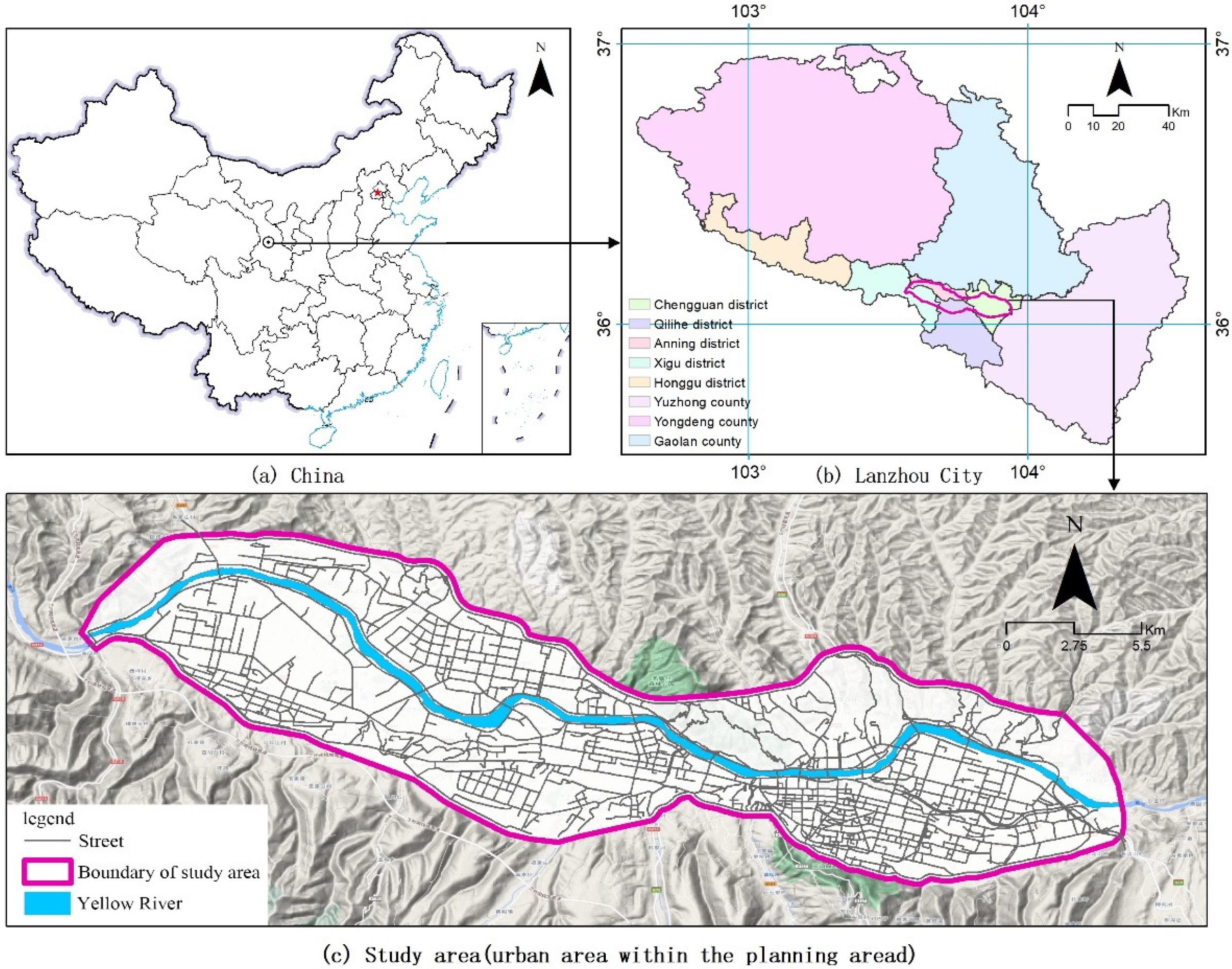
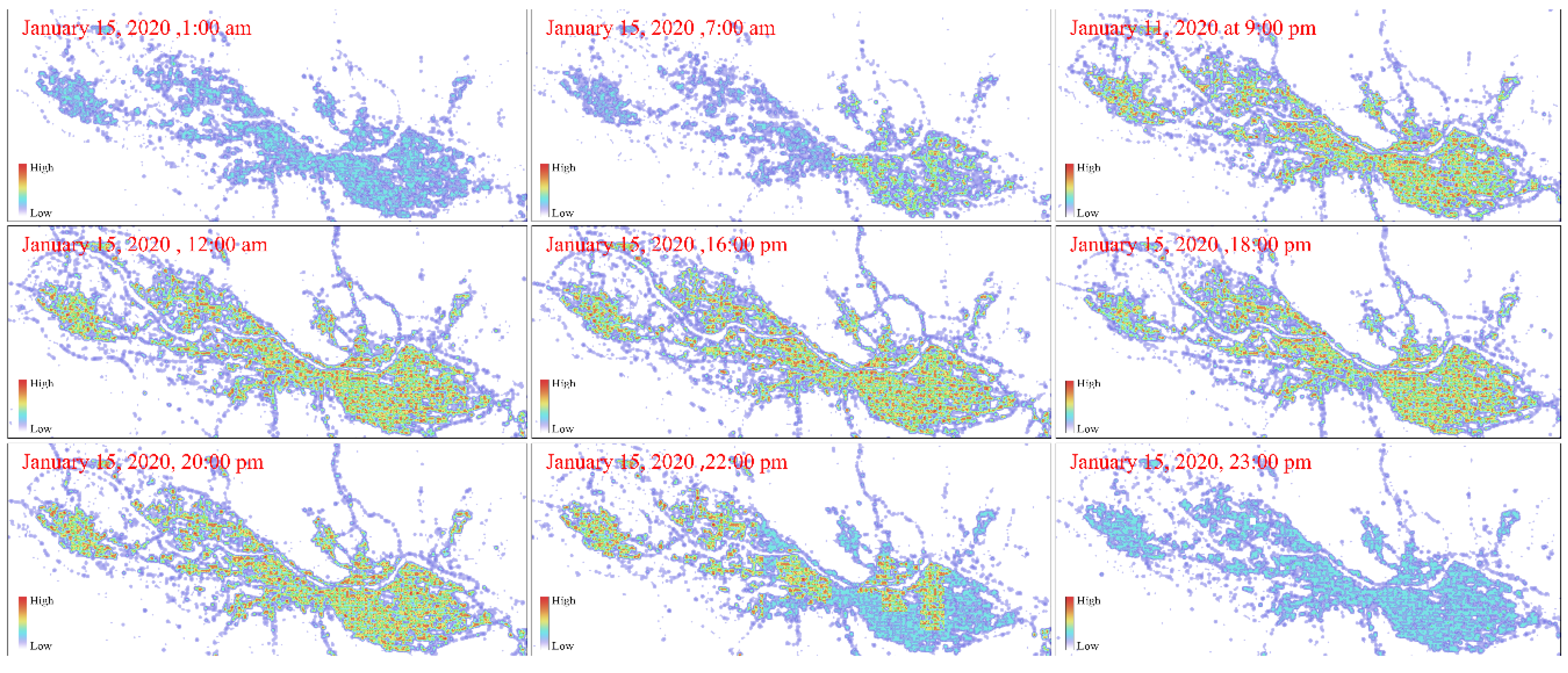
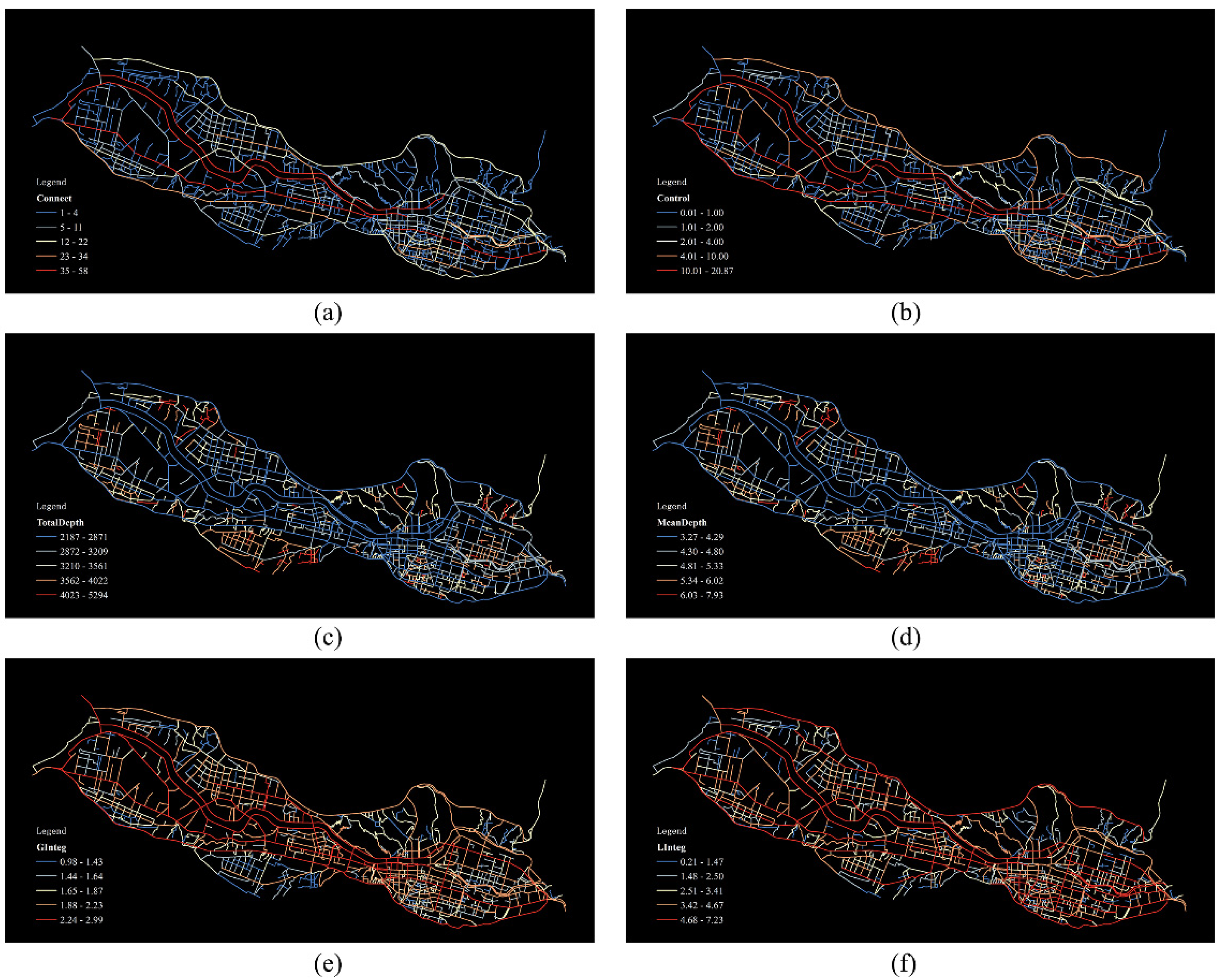
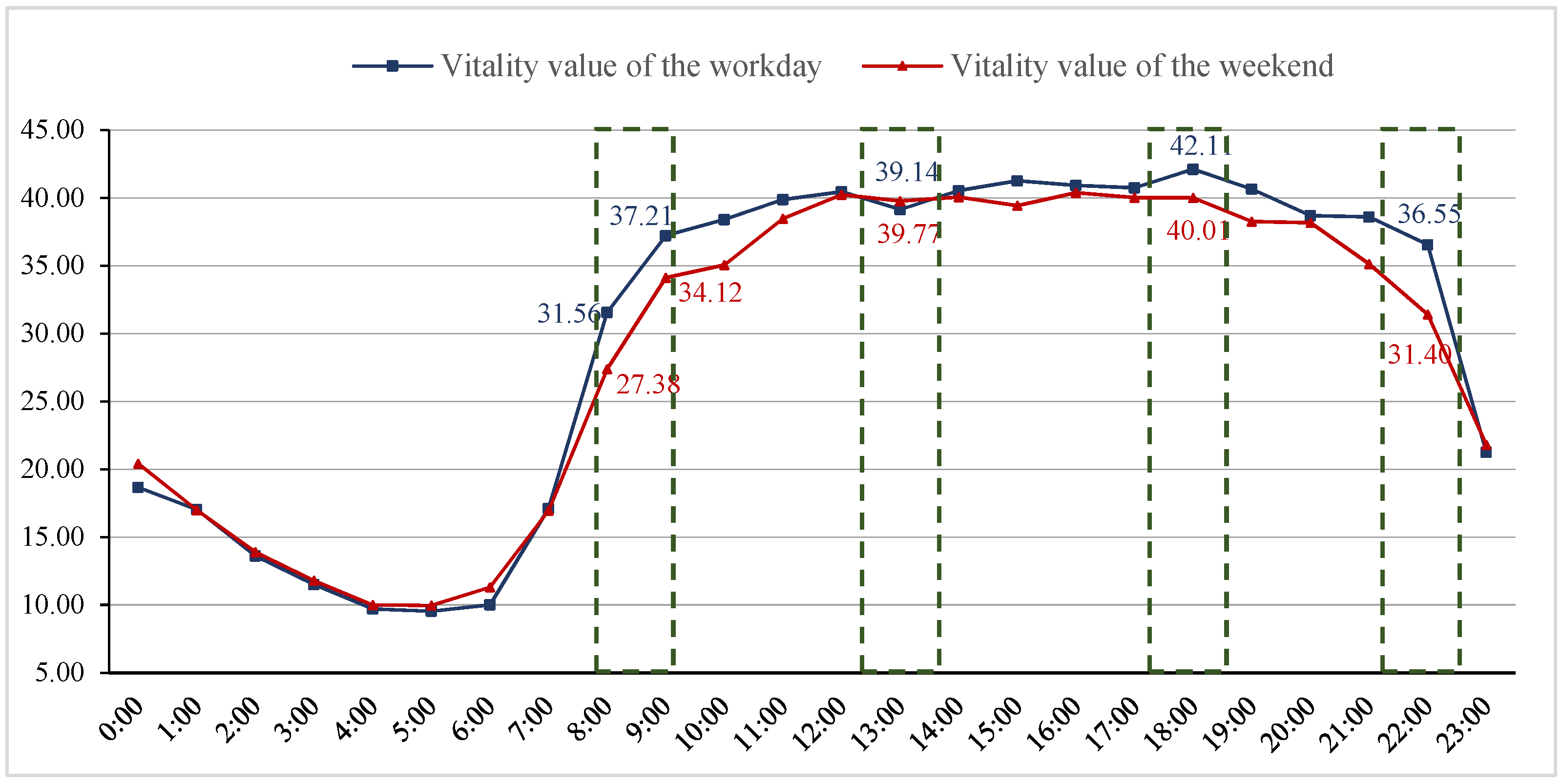
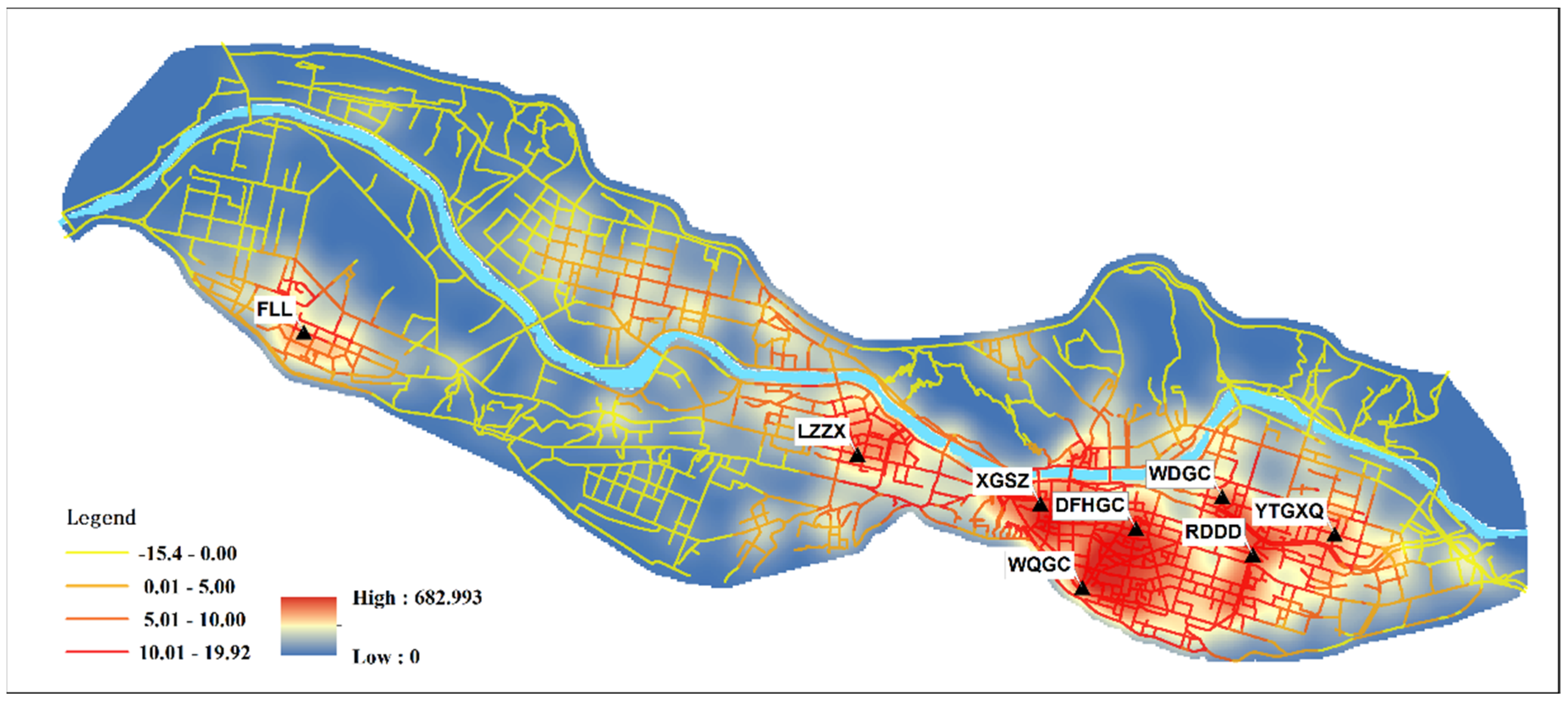
| Category | Type Description | Counting |
|---|---|---|
| Healthcare | Hospitals/Healthcare services/Clinics/Accessible facilities | 2331 |
| Recreation | Sports and leisure services /Tourist attractions/Cultural facilities/Place name and address information | 2729 |
| Life Services | Living Services/Car Sales/Public Facilities/Indoor Facilities/Gazette and Address Information | 3055 |
| Company Business | Office facilities/Place name and address information | 3280 |
| Transportation Services | Transportation facilities and services/Subway stations/Bus stops/Place name address information | 2254 |
| Car Service | Auto repair/Parking/Place name address information | 2545 |
| Financial Services | Financial and insurance services/Security facilities | 1929 |
| Catering Services | Catering Services | 3188 |
| Shopping Service | Shopping services/Car or motorcycle sales/Access to facilities/Place name and address information | 13,800 |
| Accommodation Services | Lodging Services/Hotels | 1896 |
| Educational Facilities | Elementary School/High School/University/Other Schools | 128 |
| Residential areas | Business Residence/Apartments | 1894 |
| N | MAX | AVG | MIX | S.D | ANOV | |
|---|---|---|---|---|---|---|
| Connect | 668 | 58.00 | 4.04 | 1.00 | 5.17 | 26.73 |
| Control | 668 | 20.88 | 1.00 | 0.02 | 1.72 | 2.96 |
| TotalDepth | 668 | 5294.00 | 3337.73 | 2187.00 | 462.09 | 213,525.55 |
| MeanDepth | 668 | 7.93 | 5.00 | 3.27 | 0.69 | 0.48 |
| GInteg | 668 | 3.00 | 1.76 | 0.98 | 0.31 | 0.09 |
| LInteg | 668 | 7.22 | 2.76 | 0.21 | 1.16 | 1.35 |
| Connect | Control | MeanDepth | GInteg | LInteg | ||
|---|---|---|---|---|---|---|
| workday | pearson | 0.145 ** | 0.006 ** | −0.256 ** | 0.321 ** | 0.333 ** |
| tau-b | 0.182 ** | 0.023 ** | −0.308 ** | 0.208 ** | 0.310 ** | |
| Spearman | 0.220 ** | 0.106 ** | −0.263 ** | 0.363 ** | 0.466 ** | |
| weekend | pearson | 0.024 * | −0.012 ** | −0.231 ** | 0.194 ** | 0.411 ** |
| tau-b | 0.273 ** | −0.015 * | −0.394 ** | 0.094 ** | 0.398 ** | |
| Spearman | 0.107 ** | −0.125 * | −0.245 ** | 0.345 ** | 0.450 ** |
| Variable | Model | |||
|---|---|---|---|---|
| OSL | SLM | SEM | SDM | |
| ρ | - | 0.8932 **(0.0046) | 0.8936 **(0.0047) | |
| λ | - | - | 0.9053 **(0.0044) | 0.9053 **(0.0025) |
| Constant | 7.3714 **(0.8896) | 0.2718(0.4240) | 2.6146*(0.5973) | 1.1332*(0.6215) |
| Connect | 0.1498 **(0.0110) | 0.0155 *(0.0052) | 0.0095 **(0.0066) | 0.1423 **(0.0085) |
| Control | −0.5270 **(0.0276) | −0.0856 **(0.0132) | −0.0713 **(0.0174) | −0.1514 **(0.0205) |
| MeanDepth | −0.7167 **(0.1034) | −0.0539 *(0.0492) | −0.0667 * (0.0715) | −0.1264 *(0.0707) |
| GInteg | −1.0927 **(0.1988) | −0.0689(0.0946) | −0.0390 *(0.1333) | −0.1476 *(0.1381) |
| LInteg | 0.2241 **(0.0341) | 0.1411 **(0.0162) | 0.1848 **(0.0247) | 0.0191 *(0.0252) |
| Log-likelihood | −21,314.4 | −14,534.5 | −14,522.97 | −14,641.9 |
| Mean dependent var | 2.64167 | 2.64167 | 2.641669 | 2.64167 |
| Akaike info criterion | 42,640.7 | 29,083 | 29,057.9 | 29,297.8 |
| R² | 0.0769 | 0.7914 | 0.7940 | 0.7872 |
| Robust Lagrange multiplier test | 13,559.76 (p: 0.000) | 13,582.77 (p: 0.000) | 13,011.02 (p: 0.000) | |
| Breusch–Pagan test | 88.5621 (p-value: 0.000) | 64.50 (p: 0.000) | 65.7735 (p: 0.000) | 102.93 (p: 0.000) |
| Variable | Model | |||
|---|---|---|---|---|
| OSL | SLM | SEM | SDM | |
| ρ | - | 0.8966 ***(0.0045) | 0.8965 ***(0.0046) | |
| λ | - | - | 0.9074 ***(0.0044) | 0.9231 ***(0.0038) |
| Constant | 7.7901 ***(0.8715) | 0.2493(0.4093) | 2.1232 ***(0.5777) | 1.4183 *(0.5995) |
| Connect | 0.1456 ***(0.0107) | 0.0133 **(0.0050) | 0.0052(0.0064) | 0.1409 ***(0.0081) |
| Control | −0.5089 ***(0.0271) | −0.07843 ***(0.0128) | −0.0607 ***(0.0169) | −0.1446 ***(0.01971) |
| MeanDepth | −0.7514 ***(0.1013) | −0.04548(0.0476) | −0.0107(0.0692) | −0.1562 *(0.0682) |
| GInteg | 1.2782 ***(0.19475) | −0.07140(0.0913) | 0.0155(0.1289) | 0.2252 *(0.1332) |
| LInteg | 0.2124 ***(0.0334) | 0.1312 ***(0.0157) | 0.1807 ***(0.0239) | 0.0125 *(0.0243) |
| Log-likelihood | −21,093.7 | −14,173.3 | −14,168.6 | −14,254.5 |
| Mean dependent var | 2.5086 | 2.5086 | 2.5086 | 2.5086 |
| Akaike info criterion | 42,199.4 | 28,360.6 | 28,349.1 | 28,523.1 |
| R² | 0.071 | 0.7961 | 0.7982 | 0.793 |
| Robust Lagrange multiplier test | 13,840.81 (p: 0.000) | 13,850.29 (p: 0.000) | 13,338.72 (p: 0.000) | |
| Breusch–Pagan test | 83.94 (p: 0.000) | 54.78 (p: 0.000) | 54.06 (p: 0.000) | 100.67 (p: 0.000) |
Publisher’s Note: MDPI stays neutral with regard to jurisdictional claims in published maps and institutional affiliations. |
© 2021 by the authors. Licensee MDPI, Basel, Switzerland. This article is an open access article distributed under the terms and conditions of the Creative Commons Attribution (CC BY) license (https://creativecommons.org/licenses/by/4.0/).
Share and Cite
Li, X.; Qian, Y.; Zeng, J.; Wei, X.; Guang, X. The Influence of Strip-City Street Network Structure on Spatial Vitality: Case Studies in Lanzhou, China. Land 2021, 10, 1107. https://doi.org/10.3390/land10111107
Li X, Qian Y, Zeng J, Wei X, Guang X. The Influence of Strip-City Street Network Structure on Spatial Vitality: Case Studies in Lanzhou, China. Land. 2021; 10(11):1107. https://doi.org/10.3390/land10111107
Chicago/Turabian StyleLi, Xin, Yongsheng Qian, Junwei Zeng, Xuting Wei, and Xiaoping Guang. 2021. "The Influence of Strip-City Street Network Structure on Spatial Vitality: Case Studies in Lanzhou, China" Land 10, no. 11: 1107. https://doi.org/10.3390/land10111107
APA StyleLi, X., Qian, Y., Zeng, J., Wei, X., & Guang, X. (2021). The Influence of Strip-City Street Network Structure on Spatial Vitality: Case Studies in Lanzhou, China. Land, 10(11), 1107. https://doi.org/10.3390/land10111107






